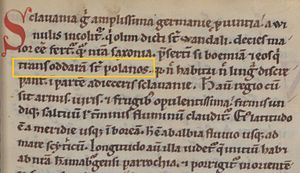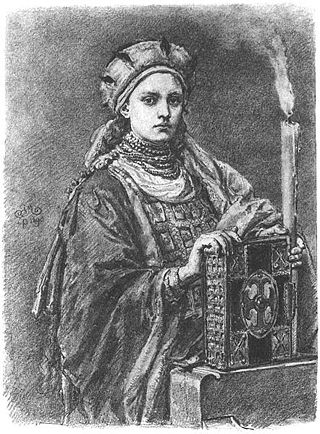
Doubravka of Bohemia, Dobrawa was a Bohemian princess of the Přemyslid dynasty and by marriage Duchess of the Polans.

Mieszko I was the first ruler of Poland and the founder of the first independent Polish state, Civitas Schinesghe also known as the Duchy of Poland. His reign stretched from 960 to his death and he was a member of the Piast dynasty, a son of Siemomysł and a grandson of Lestek. He was the father of Bolesław I the Brave and of Gunhild of Wenden. Most sources identify Mieszko I as the father of Sigrid the Haughty, a Scandinavian queen, the grandfather of Canute the Great and the great-grandfather of Gunhilda of Denmark, Canute the Great's daughter and wife of Henry III, Holy Roman Emperor.
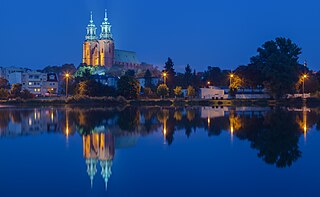
Gniezno is a city in central-western Poland, about 50 kilometres east of Poznań. Its population in 2021 was 66,769, making it the sixth-largest city in the Greater Poland Voivodeship. One of the Piast dynasty's chief cities, it was the first historical capital of Poland in the 10th century and early 11th century, and it was mentioned in 10th-century sources, possibly including the Dagome Iudex, as the capital of Piast Poland.
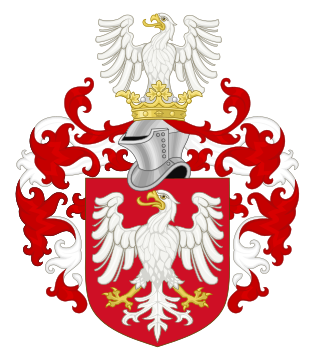
The House of Piast was the first historical ruling dynasty of Poland. The first documented Polish monarch was Duke Mieszko I. The Piasts' royal rule in Poland ended in 1370 with the death of king Casimir III the Great.

The Duchy of Greater Poland was a district principality in Greater Poland that was a fiefdom of the Kingdom of Poland. It was formed in 1138 from the territories of the Kingdom of Poland, following its fragmentation started by the testament of Bolesław III Wrymouth. In 1177, the state broke had separated into the duchies of Poznań, Gniezno and Kalisz, and united again in 1279, lasting in that form until 1320, when it was incorporated back into the Kingdom of Poland. Its capital was Poznań.

Lestek was the second duke of Polans, and son of Siemowit, born c. 870–880, mentioned in the oldest Polish chronicle, Gesta principum Polonorum by Gallus Anonimus. The dukes of Polans were the foundation of the Piast dynasty, the first historical ruling dynasty of Poland.

Siemomysł or Ziemomysł was the third duke of Polans of the Piast dynasty, and the father of Poland's first Christian ruler, Mieszko I. He was listed by Gallus Anonymous in his Gesta principum Polonorum and was the son of Lestek, the second known Duke of the Polans. According to Gallus' account and historical research, Siemomysł has been credited with leaving the lands of the Polans, Goplans and Masovians to his son Mieszko I, who further expanded them during his reign.
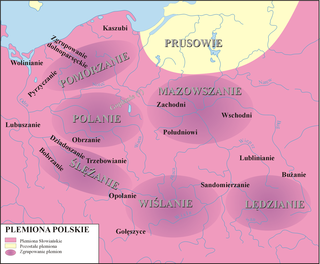
"Polish tribes" is a term used sometimes to describe the tribes of West Slavic Lechites that lived from around the mid-6th century in the territories that became Polish with the creation of the Polish state by the Piast dynasty. The territory on which they lived became a part of the first Polish state created by duke Mieszko I and expanded at the end of the 10th century, enlarged further by conquests of king Bolesław I at the beginning of the 11th century.

This article covers the history of Poland in the Middle Ages. This time covers roughly a millennium, from the 5th century to the 16th century. It is commonly dated from the Fall of the Western Roman Empire, and contrasted with a later Early Modern Period. The time during which the rise of humanism in the Italian Renaissance and the Reformation unfolded is generally associated with the transition out of the Middle Ages, with European overseas expansion as a succeeding process, but such dates are approximate and based upon nuanced arguments.

The Vistulans, or Vistulanians, were an early medieval Lechitic tribe inhabiting the western part of modern Lesser Poland.

The Christianization of Poland refers to the introduction and subsequent spread of Christianity in Poland. The impetus to the process was the Baptism of Poland, the personal baptism of Mieszko I, the first ruler of the future Polish state, and much of his court. The ceremony took place on Holy Saturday, 14 April 966, although the exact location is disputed by historians, with the cities of Poznań and Gniezno being the most likely sites. Mieszko's wife, Dobrawa of Bohemia, is often seen as a major influence on Mieszko's decision to accept Christianity.

Lebus is a historic town in the Märkisch-Oderland District of Brandenburg, Germany. It is the administrative seat of Amt Lebus. The town, located on the west bank of the Oder river at the border with Poland, was the centre of the historical region known as Lubusz Land, which provides the name for the present-day Polish Lubusz Voivodeship.
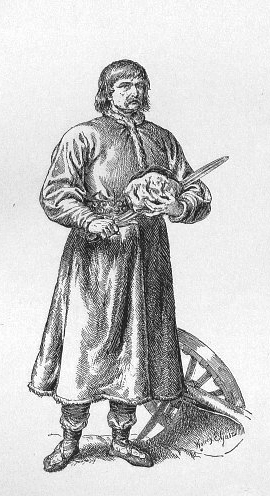
Piast the Wheelwright was a semi-legendary figure in medieval Poland, and the presumed founder of the Piast dynasty that would rule the future Kingdom of Poland.

The Lendians were a Lechitic tribe who lived in the area of East Lesser Poland and Cherven Cities between the 7th and 11th centuries. Since they were documented primarily by foreign authors whose knowledge of Central and East Europe geography was often vague, they were recorded by different names, which include Lendzanenoi, Lendzaninoi, Lz’njn, Lachy, Lyakhs, Landzaneh, Lendizi, Licicaviki and Litziki.
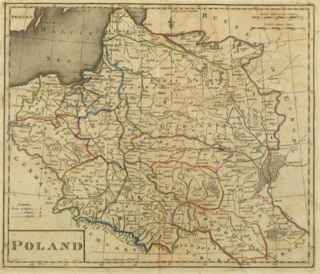
The ethnonyms for the Poles (people) and Poland include endonyms and exonyms. Endonyms and most exonyms for Poles and Poland derive from the name of the West Slavic tribe of Polans (Polanie), while in some languages the exonyms for Poland to derive from the name of another tribe – the Lendians (Lędzianie).
Lechites, also known as the Lechitic tribes, is a name given to certain West Slavic tribes who inhabited modern-day Poland and eastern Germany, and were speakers of the Lechitic languages. Distinct from the Czech–Slovak subgroup, they are the closest ancestors of ethnic Poles and of Pomeranians, Lusatians and Polabians.

The Silesians were a tribe of West Slavs, specifically of the Lechitic/Polish group, inhabiting territories of Lower Silesia, near Ślęża mountain and Ślęza river, on both banks of the Oder, up to the area of modern city of Wrocław. They were the first permanent inhabitants of the site of Wrocław where they build a fort on Ostrów Tumski in the 9th century or earlier, which at the time was an island on the Oder.

The most important phenomenon that took place within the lands of Poland in the Early Middle Ages, as well as other parts of Central Europe was the arrival and permanent settlement of the West Slavic or Lechitic peoples. The Slavic migrations to the area of contemporary Poland started in the second half of the 5th century AD, about a half century after these territories were vacated by Germanic tribes fleeing from the Huns. The first waves of the incoming Slavs settled the vicinity of the upper Vistula River and elsewhere in the lands of present southeastern Poland and southern Masovia. Coming from the east, from the upper and middle regions of the Dnieper River, the immigrants would have had come primarily from the western branch of the early Slavs known as Sclaveni, and since their arrival are classified as West Slavs and Lechites, who are the closest ancestors of Poles.

The period of rule by the Piast dynasty between the 10th and 14th centuries is the first major stage of the history of the Polish state. The dynasty was founded by a series of dukes listed by the chronicler Gall Anonymous in the early 12th century: Siemowit, Lestek and Siemomysł. It was Mieszko I, the son of Siemomysł, who is now considered the proper founder of the Polish state at about 960 AD. The ruling house then remained in power in the Polish lands until 1370. Mieszko converted to Christianity of the Western Latin Church in an event known as the Baptism of Poland in 966, which established a major cultural boundary in Europe based on religion. He also completed a unification of the Lechitic tribal lands that was fundamental to the existence of the new country of Poland.

Czcibor, a member of the Piast dynasty, was a Polan prince, son of Duke Siemomysł and younger brother of the first Christian ruler, Mieszko I of Poland.

